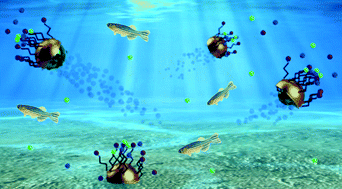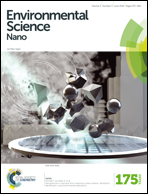Self-propelled chelation platforms for efficient removal of toxic metals†
Abstract
Water-powered ligand-modified micromotors that offer efficient ‘on-the-fly’ chelation of heavy metal contaminants are described. The Janus micromotors are prepared by functionalizing Mg/Au microsphere motors with a self-assembled monolayer of meso-2,3-dimercaptosuccinic acid (DMSA). The resulting micromotors propel autonomously in complex environmental and biological matrices, containing chloride and surfactant, obviating the need for external (peroxide) fuel or expensive Pt catalysts. Such self-propelled micromotors act as highly efficient dynamic chelation platforms that offer significantly shorter and more efficient water remediation processes compared to the common use of static remediation agents. The effective decontamination capability of the DMSA-based Janus micromotors is illustrated towards the rapid removal of Zn(II), Cd(II) and Pb(II). Factors influencing the micromachine-enhanced metal chelation process, such as the navigation time and number of motors, have been investigated. High removal efficiencies of ∼100% are obtained for all target metals following 2 min treatment of serum, seawater or lakewater samples spiked with 500 μg L−1 of each heavy metal. The chelation mechanism has been characterized using the Langmuir model, indicating strong interaction and monolayer-type adsorption of the target heavy metals onto the DMSA-binding layer. The new nanomotor concept holds considerable promise towards future metal remediation applications.


 Please wait while we load your content...
Please wait while we load your content...